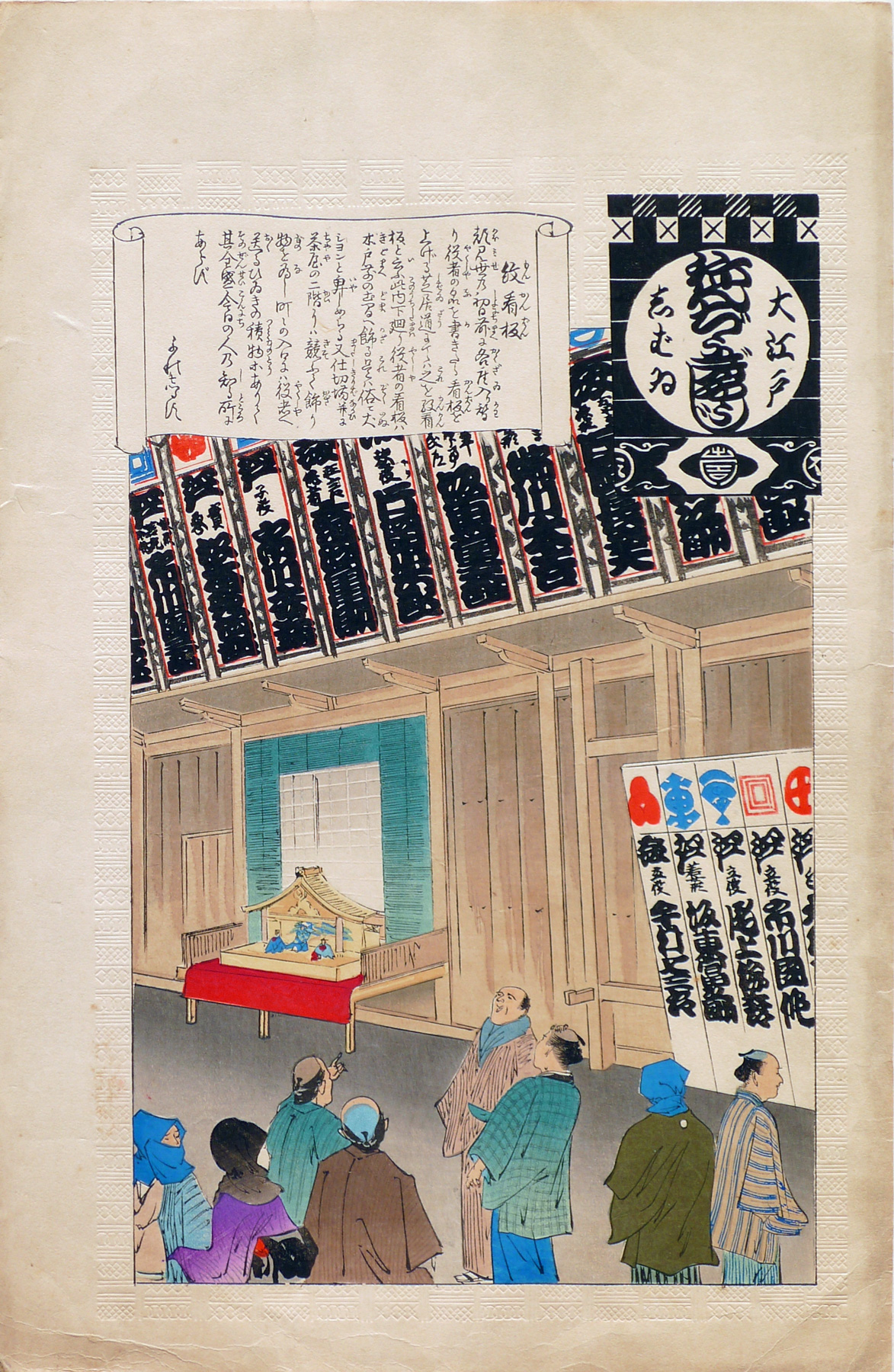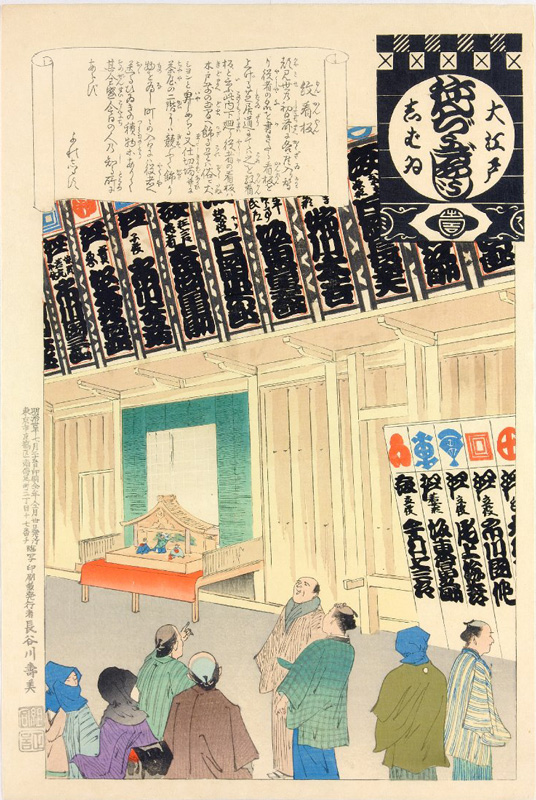About This Print
Source: The British Museum http://www.britishmuseum.org/research/search_the_collection_database/search_object_details.aspx?objectid=781197&partid=1&searchText=adachi+ginko&fromADBC=ad&toADBC=ad&numpages=10&orig=%2fresearch%2fsearch_the_collection_database.aspx¤tPage=2This print, part of a series of twenty-five prints (plus a prolog/index print) picturing events in a typical year in an Edo theater, depicts signboards giving the names and crests of the actors who will appear at the theater that season.
Monkanban
During Kaomise performance term, boards called Monkanban (lit. signboard with crest), were displayed in front of a theater. [On] every Monkanban, [the] name of an actor who contracted with the theatre and his crest was printed.
Shitamawari were lower class actors before [being] promoted to Nadai, and usually their names were printed together on a single board. This was called "dog pee" because their board was displayed in the very bottom where even [a] dog can pee.
In this picture, the miniature ornament of Sanbasou, a dance program, is displayed in front of the green blind. The back of the blind is Shikiriba, theater office, and they often used its front space as show window, putting a small stand [that] displayed a miniature scale stage. Shibaijyaya also displayed the ornaments and curtain on the roof and this added floridness to the theater district.
Miniature scales of stages were reproduced as Kumiage-e, a kind of Ukiyo-e designed for paper craft, by Kami soushi-ya, publishers doubled as distributor, and sold to the general public. Therefore people could enjoy various Kabuki programs not only in the theater but also at home.
About This Series
Source: Tokyo Metropolitan Library http://www.library.metro.tokyo.jp/Portals/0/edo/tokyo_library/english/modal/print.html?d=20; ARC http://www.arc.ritsumei.ac.jp/lib/vm/kabuki2015_e/2015/11/oedo-shibai-nenjyu-gyoji.html and from personal observation.
Ōedo Shibai Nenjū Gyōji (Annual Events of the Edo Theater) drawn by Adachi Ginko [with two prints, Yomitate (Public Reading) and Saruwaka Kyōgen (IHL Cat. #2015), contributed by Torii Kiyosada (1844-1901)] is a set of twenty-six prints (including an index/prologue page), depicting the manners and customs relating to Kabuki plays/theaters in the Saruwaka-chō, the Kabuki theater district which flourished until 1867, the first year of the Meiji Era. The Ritsumeikan Art Research Center posits that this series was issued in response to the public's "remarkable nostalgia for [the] Edo period, the 'Great Tokugawa Epoch'." It goes on to say that this series is a continuation of the many earlier Kabuki theater guidebooks which "introduce[d] not only about things on a stage but also properties, organization of theatres and backstage."
Three Editions
At least three editions of this series were released. One edition, likely the first edition, contains the publisher's name, Hasegawa Sumi, and associated publishing and printing information along the left margin. This first edition, with the publishing information, is often found bound into volumes, with the margins of the prints trimmed back. My guess is that these bound volumes were created by the publisher. Another edition, likely a second edition, uses an embossed border around the entire image which is not present on the earlier edition. Generally these second edition prints have wider margins than the first edition. It is possible that these second edition prints were sold by subscription. A third edition, which appears to be printed from new blocks, as differences in composition in each print can be seen, is a less elaborate printing than the earlier editions. Interestingly, this later edition uses the convention called komochiki of a thick notched line and thin black line framing the subjects, a popular Edo textile pattern thought to reflect iki taste (Edo chic). Use of this type of framing is associated with kōkanfuda, a type of votive offering print. (See IHL Cat. #1686 A Set of Three Nōsatsu Kōkanfuda - Fūjin the Wind God, Raijin the Thunder God, Calligraphic Cover Sheet for more information about kōkanfuda.)
Summary of Differences Between the Three Editions1. First edition prints contain the publishing and printing information, including dates, along the left margin. In the later edition of prints only the Index/Prologue print contains any publishing information, with the publishing house 長谷川 板 (Hasegawa han), proceeded by the publisher's address embossed in the lower left corner. No date is given on this print or any other later edition prints.2. Most first edition prints contain the artist's signature and/or seal. Later editions do not carry the artist's signature or seal.3. Second edition prints contain an approximately 1/2" wide embossed border around the entire image area not present on the first edition.4. Some second edition prints may have had the original blocks reworked.5. Third edition prints were printed from new blocks and all have a thick notched line and thin black line framing the subjects.
At least three editions of this series were released. One edition, likely the first edition, contains the publisher's name, Hasegawa Sumi, and associated publishing and printing information along the left margin. This first edition, with the publishing information, is often found bound into volumes, with the margins of the prints trimmed back. My guess is that these bound volumes were created by the publisher. Another edition, likely a second edition, uses an embossed border around the entire image which is not present on the earlier edition. Generally these second edition prints have wider margins than the first edition. It is possible that these second edition prints were sold by subscription. A third edition, which appears to be printed from new blocks, as differences in composition in each print can be seen, is a less elaborate printing than the earlier editions. Interestingly, this later edition uses the convention called komochiki of a thick notched line and thin black line framing the subjects, a popular Edo textile pattern thought to reflect iki taste (Edo chic). Use of this type of framing is associated with kōkanfuda, a type of votive offering print. (See IHL Cat. #1686 A Set of Three Nōsatsu Kōkanfuda - Fūjin the Wind God, Raijin the Thunder God, Calligraphic Cover Sheet for more information about kōkanfuda.)
Summary of Differences Between the Three Editions
1. First edition prints contain the publishing and printing information, including dates, along the left margin. In the later edition of prints only the Index/Prologue print contains any publishing information, with the publishing house 長谷川 板 (Hasegawa han), proceeded by the publisher's address embossed in the lower left corner. No date is given on this print or any other later edition prints.
2. Most first edition prints contain the artist's signature and/or seal. Later editions do not carry the artist's signature or seal.
3. Second edition prints contain an approximately 1/2" wide embossed border around the entire image area not present on the first edition.
4. Some second edition prints may have had the original blocks reworked.
5. Third edition prints were printed from new blocks and all have a thick notched line and thin black line framing the subjects.
The below first edition print contains the publishing and printing information along the left margin that is absent from this collection's print.
Print Details
| IHL Catalog | #764 |
| Title or Description | Mon Kanban 紋看板 (Crest signboards) |
| Series | Annual Events of the Edo Theatre Ō-Edo shibai nenjū-gyōji 大江戸しばゐねんぢうぎやうじ |
| Artist | Adachi Ginkō (active 1874 – 1897) |
| Signature | unsigned |
| Seal | no seal |
| Publication Date | 1897, July 30 (Meiji 30) note: The original publication date of the first edition is 1897. The publication date of this collection's print, a second edition, is unknown. |
| Publisher | Hasegawa Sumi 長谷川 寿美 [Publisher seal is not present on this print] |
| Carver | unknown |
| Printer | |
| Impression | excellent |
| Colors | excellent |
| condition | good - full size; not backed; soiling, primarily in margins; wrinkling |
| Genre | ukiyo-e; yakusha-e |
| Miscellaneous | an approximately 1/2" wide embossed pattern surrounds the image area |
| Format | vertical oban |
| H x W Paper | 17 3/8 x 11 1/4 in. (44.1 x 28.6 cm) |
| H x W Image | 14 5/8 x 9 1/2 in. (37.1 x 24.1 cm) including embossed area around the image |
| Literature | |
| Collections This Print | British Museum 1983,0523,0.3.19; Waseda University Cultural Resource Database 201-0208 and 201-0704; Museum of Fine Arts Boston RES.53.42; National Diet Library 1309619; Edo-Tokyo Museum (Tokyo Digital Museum 91970054); Tokyo Metropolitan Library 577-010-19ア; Art Research Center, Ritsumeikan University AcNo.国会456-00-019;cNo.arcUP2058 |
2/15/2020



